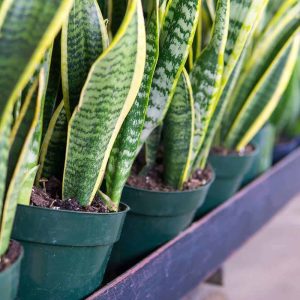Why Are My Snake Plant Leaves Getting Soft and Mushy?
One of the most important causes for your snake plant leaves are turning soft or mushy is overwatering or root rot.
Here are a few conditions on why your Snake plant’s leaves may have turned soft –
1. Incorrect Potting Mix

Incorrect potting mix for snake plants is usually poorly-drained—these plants prefer to be potted in a well-draining, loose soil mix. However, they thrive in sandy soil mixtures. Snake plants dislike potting soils high in clay, peat, or dense organic. They can get packed together, thick, and hard to drain.
Such potting media can quickly become soggy or overly wet. Furthermore, because they take so long to drain, your snake plant will be standing on “wet feet” and likely develop root rot. The rot disease attacks the root system and then progresses to the leaves. Overwatering, edema, and fungal infections will cause the foliage to soften.
How to Fix
Replace the soil or any potting mix you use completely so that there is no moist soil remaining in the container. It would be good for your plant if you trimmed away the mushy or rotten roots.

2. Excess Water
Watering your snake plant too frequently invites trouble. Overwatering not only causes browning of the leave but also softening and mushiness. Soft, water-soaked spots on the foliage are one of the first indications of overwatering.
The result is edema/swelling, a condition in which cells and tissue burst under the pressure of the excess absorbed water. The leaves will lose their turgidity and become soft as a result.
Unfortunately, Overwatering also causes the leaves to become wet and susceptible to fungal diseases that cause them to become soft and spotty.
Solution
Stopping watering and repotting your snake plant are two of the most common remedies for overwatering. Soft, water-soaked spots on the foliage are one of the first indications of overwatering.
The leaves will lose their turgidity and become soft as a result. Unfortunately, Overwatering also causes the leaves to become wet and susceptible to fungal diseases that cause them to become soft and spotty.
3. Root Rot

Overwatering is almost always the cause of root rot. It’s one of the few things that can turn your prized snake plant mushy and kill it. Soft or mushy leaves indicate a severe case of root rot. When you take your plant out of its pot, you’ll notice it has black/brown, slimy, and stinky roots.
How to Solve
It’s a race against time to save your snake plant from root rot. You may need to cut almost all the roots and treat the remaining ones with fungicide. Repot your plant in a new pot with fresh potting soil.
4. Cold Damage

Snake plants cannot withstand frost, cold drafts, or temperatures below 50°F (10°C). As the tissue dies from cold damage, the leaves droop, turn yellow to brown, and become soft.
Softening and browning will eventually spread down the leaves toward the plant’s base. The leaves closest to the source of cold are the first to soften. If you do not act quickly, your entire snake plant will suffer from cold damage or shock.
Solution
Temperatures between 70 and 90°F (21 and 32°C) are best for snake plants. Never allow temperatures to fall below 50°F (10°C). Also, protect your plant from cold drafts.
277 total views, 1 views today




